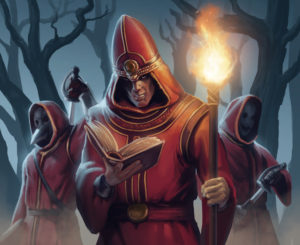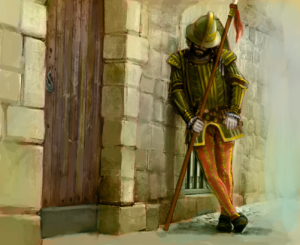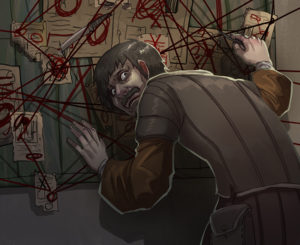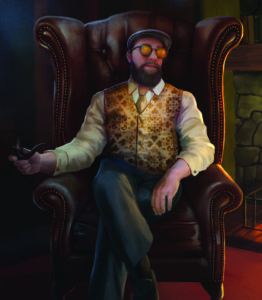In my previous post, I promised that I would write up something about art directing and dealing with freelancers. I’ve got all my illustrations for No Honor Among Thieves at this point, and am in the process of getting things sent to the manufacturer for them to do their part, so I figured now would be a good time to sit back and talk about that, since I have such recent experience with it.
Where Do I Find Freelance Artists?
I am a member of a bunch of different Facebook groups, subreddits, and other forums where new and experienced tabletop designers and publishers can ask questions of each other. One that I see come up very often is some variation of the following: “Where can I find artists to work on my project?”
This is something that I struggled with for a while. At first I tried contacting artists directly based on their DeviantArt profiles, which didn’t really work out. The few artists who bothered to reply to my query emails responded that they were too busy to take on additional work, or asked for more details and then never replied further when I got back to them. I’ve heard that some people have had good results from commissioning artists that they found on DevientArt, but I personally have never had any luck with it.
If you want to do the same thing on a website that is actually composed of concept and game artists looking for work, I would suggest browsing ArtStation rather than DeviantArt. You’re more likely to run into people who are actual professional artists instead of hobbyists.
You don’t really need to search for artists, though. You can get them to come to you very easily by posting a job on freelancer sites like Guru.com or Fiverr — I got great art from artists on both of those sites. Leave the job posting up for a week, and if your post is well written you should get twenty to forty replies from different artists. The aforementioned ArtStation also lets you post jobs, but charges you $150 for each one that you post, which is a bit much for your average indie Kickstarter.
In general, posting jobs and letting people apply will let you find artists much faster than seeking them out yourself.

How Do I Write the Job Posting?
There are certain elements that you need in the job posting to ensure that you get the sort of artist you’re looking for. The first time I made one of these postings, I got a lot of artists that just weren’t suitable at all for what I needed, and had to spend a lot of time sorting through them. The second time I was much more specific with what I wanted, which saved me a lot of effort.
- Describe the style of art that you want, and provide links to examples. Find something on Google Image Search that looks like what you’re going for.
- Outline your budget. How much are you willing to pay for illustrations? Mention your maximum cutoff in the initial posting and you won’t spend as much time staring at amazing portfolios wishing you could afford to hire them.
- Mention in the post that applicants should provide a link to a portfolio. I know this seems obvious, but if you don’t mention it then sometimes people don’t bother. If they send you an application without a portfolio after you’ve put it in the job posting, then you know that they can’t follow basic written instructions and you probably don’t want to work with them.
- Describe the scope of the work. Are you going to be assigning an artist a dozen illustrations? Two? A hundred?
- Definitely link to your Kickstarter page or other web presence so that prospective artists can get a better idea of the themes you’re trying to get across with the art.
Include these elements, and you should get a much more focused and specific group of freelancers looking for work.

Which Artist(s) Should I Work With?
The people who respond to your job posting on freelancer websites can usually be broken down into a couple of broad categories.
- Design companies with staff, a logo, and a professional proposal. These can range from companies with wildly different skills than what you were looking for that were obviously just going through every new post in the Illustrations category and replying to it with a form letter, to companies that actually look competent and could probably do everything you need them to. I’ve never worked with any of these companies, personally. I like to have a personal relationship with my freelancers, and I like to review a specific person’s portfolio rather than not be sure which artist out of half a dozen at the company I’ll be getting.
- Companies and individuals who grossly misunderstood what you are looking for and obviously either misread or ignored the text of the job posting. For example, every time I have posted a new job on one of these sites I have received responses from programmers offering to build websites or apps for me. Sorry, buddy, but that’s not at all what the posting was about.
- Individual artists who understood the posting and are ready to work. Those are the people you have to sort through to narrow down who you want to work with.
When you’re sorting your artist applications, you need to answer a couple of questions for each one of them.
Does this artist do good work in the style I’m looking for? Go over their portfolio of previous work and make sure it looks good. Keep an eye out for issues like wonky perspective, mushy shading, and unsettling proportions. Also note any peculiarities of their style. For example, if the pieces in their portfolio are all character art with no backgrounds, don’t expect them to be able to draw landscapes or complicated machinery or anything that isn’t character art with no backgrounds. Also pay attention to their style in general — if you’re looking for realistic drawings and their portfolio is entirely cartoons, that’s probably not someone you want to hire for this job.
Does this artist have any issues communicating in English? Thanks to the Internet, you can work with artists from all over the world, which means you’re going to be talking to a lot of people for whom English is a second language. Usually that’s not a problem, but very occasionally you’ll come across a message from an artist with great work but who you can’t really communicate with. You can still work with those people, but realize that it’s going to be more difficult, and take more time.
How much does this artist charge per illustration? From my experience commissioning card art, prices can range anywhere from $30 per illustration to $200+. In general, my rule is that if an artist charges $60-$100 for a small colored illustration for a card, then that’s an artist to keep on file. If they charge over $100, then you might want to consider only using them for the larger or more important pieces of art. If they charge over $200, you could probably use them if your game doesn’t have that many cards and you’re flush with cash, but otherwise you can find people who will work for cheaper. If your game requires larger pieces of art than cards, be prepared to pay $150 and up, all the way to $400-$600 for covers or boards.
Is this artist reliable? There’s not really any good way of telling this. The freelancer sites tend to let employers review freelancers and vice-versa, so you can sometimes go off of those, but the best way to tell if someone is reliable or not is to work with them. I like to assign one or two small pieces to an artist before working with them more extensively, to see how fast they work and how reliably they deliver, but even with the best people sometimes things come up unexpectedly. Over the course of getting illustrations for No Honor Among Thieves I had multiple artists get sick, one hard drive crash, and one poor guy who had his apartment flood while he was trying to work on my art. The best way I can say to build up reliability is to have a stable of artists that you know and can work with, and know who is fast enough that you could potentially sub them in if another artist becomes unable to complete their work.
If you want to have only one artist illustrating your game, obviously that approach won’t work. In that case, you’ll have to be extra careful when coming up with that initial relationship. I cannot stress enough the importance of working with your artists ahead of time if you’re able. You need to know how long they will take to complete illustrations, how much instruction they need and if they can follow instructions given. You need to know if they will communicate when things go wrong, and you need to know that they’re good for the work. Even then, be sure to build in an extra month (at least!) to your illustration schedule, just in case something goes wrong. Because something will go wrong. That’s life.

How Do I Pay My Artists?
Never, ever, pay in advance. Unless you know the artist personally, have worked with them many times before, and are willing to never see that money again if worse comes to worst. I made this mistake once, and then never again.
Escrow is your friend. If you don’t want to figure out an escrow service (some of the freelancer sites, such as Guru.com, offer them for free — read through the documentation of the sites you decide to use) then I suggest a simple half now, half later approach.
You may want to come up with a freelancer contract for your artists to sign, especially if you’re heavily working with one in particular or aren’t working through a freelancer site with its own contract built-in. You can find basic templates for this sort of thing all over the internet. Pick and choose the language you want to use. What you want is a work-for-hire agreement, unless you’ve decided to split profits with your artist, in which case you should probably consult a lawyer instead of asking the opinion of a part-time game designer offering anecdotal advice.

Conclusion
I think that covers most everything. Remember to check in with your artists if you haven’t heard from them in a while just in case something’s gone wrong, get them to keep you updated with sketches and the like so you know how things are progressing and can make changes when it would be easy to make them, and always be polite and understanding. Treating people with respect and courtesy goes a long way towards getting good work done.
If you have any questions about any aspect of hiring and working with artists, please feel free to ask in the comments. I don’t have experience with profit sharing agreements and the like, so I can’t offer advice on that, but I have worked with a dozen or so different artists over the course of this project, and I think I’ve gotten the hang of it at this point. Hopefully this is helpful to someone.


sergi ,
Very nice! 🙂